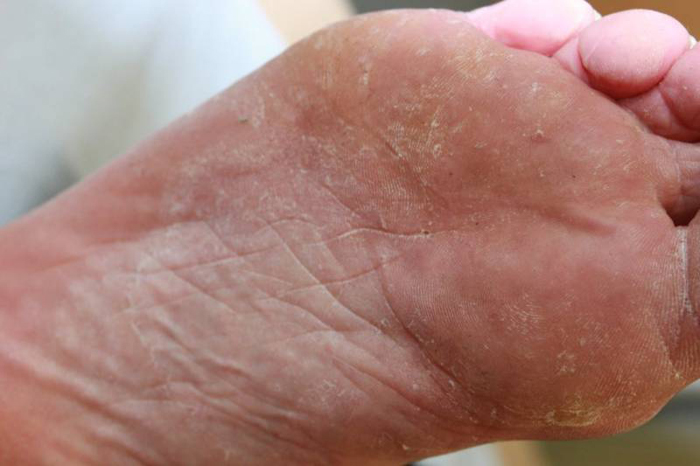
Tinea pedis is a dermatophytic infection of the feet, characterized by erythema, scaling, maceration, and/or bulla formation. In most cases of epidermal dermatophytosis, the infection occurs initially on the feet, and, in time, spreads to sites such as the inguinal area (tinea cruris), trunk (tinea corporis), hands (tinea manuum). Tinea pedis often provides breaks in the integrity of the epidermis through which bacteria such as Staphylococcus aureus or group A streptococcus can invade causing localized infection or spreading infections such as cellulitis or lymphangitis.
Causes of Tinea Pedis
- Tinea pedis is caused by a fungus that is only mildly contagious. Everyone is exposed to the fungus which causes tinea pedis; why only some people get it is unknown.
- Tinea pedis may stay in the skin indefinitely. Even if the rash seems to have been cured, microscopic examination may reveal the fungus to be present. While medicines will clear up the rash, the fungus may merely be “lying low” and may cause the same rash again.
Symptoms of Tinea Pedis
- White Scaly Skin causes an itching on the bottom of the foot and in between the toes. The skin will eventually soften, causing the whitish borders to peel off easily. The center of the lesion may be irritated, red, and in some cases, a watery discharge can be seen.
- Other types of Tinea Pedis may be the moccasin variety (white, thick, dense and scaly sole), which consists of large areas of cracked skin, inflammation, fluid field vesicles or bullae.
- White/pink Scaly Skin in the affected areas, with no itching whatsoever.
Diagnosis
Demonstration of hyphae on direct microscopy, ±isolation of dermatophyte on culture.
Treatment
Special considerations by type of infection
- Macerated interdigital Acute: Burow’s wet dressings; Castellani’s paint. Chronical: aluminum chloride hexahydrate 20% bid to reduce sweating.
- Inflammatory/bullous Acutely, use cool compresses. If severe, systemic glucocorticoids are indicated.
Antifungal agents
- Topical See Dermatophytoses. Apply to all affected sites twice daily. Treat for 2-4 weeks
- Systemic Indicated for extensive infection, for failures of topical treatment, or for those with tinea unguium and moccasin-type tinea.
Secondary prophylaxis
Important in preventing recurrence of interdigital and moccasin types of tinea pedis. Daily washing of feet while bathing with benzoyl peroxide bar is effective and inexpensive. Antifungal powders.
Prevention
Use of shower shoes while bathing at home or in public facility. Washing feet with benzoyl peroxide bar directly after shower. Diabetics and those who have undergone coronary artery bypass with harvesting of leg veins are especially subject to secondary bacterial infection (impetiginization, lymphangitis, cellulitis).
References